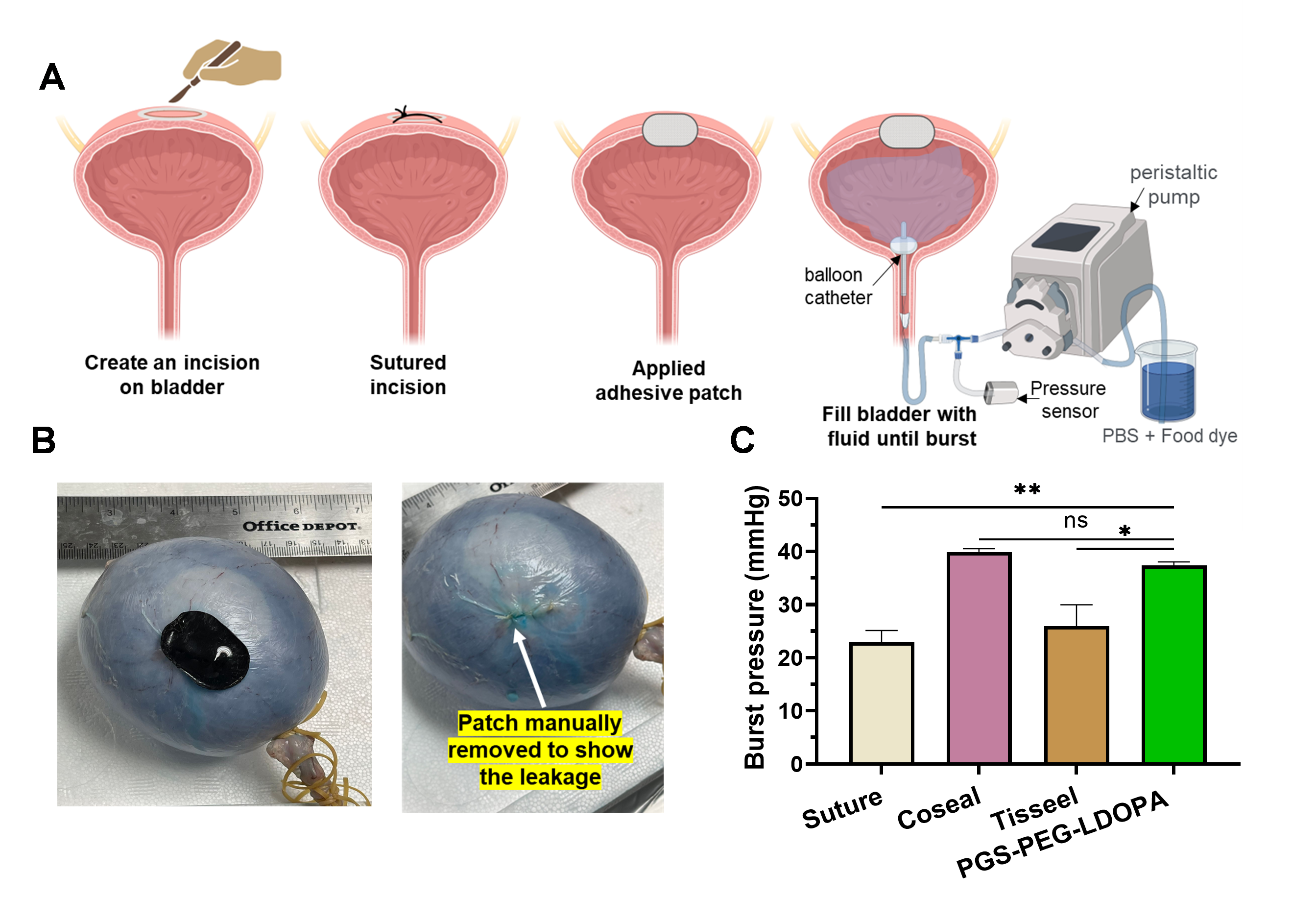Bioabsorbable and Elastic Bioadhesive Patch for Suture Line Reinforcement in the Lower Urinary Tract
Reihaneh Haghniaz, PhD1, George Aninwene, PhD2, Fahimeh Zarei, Master1, Juan Pamirez, Bachelor2, Kalpana Mandal, PhD1, Marvin Mecwan, PhD1, Hossein Montazerian, PhD2, Peyton Tebon, PhD2, Ali Khademhosseini, PhD1, Renea Sturm, MD2.
1Terasaki Institute for Biomedical Innovation, Woodland Hills, CA, USA, 2University of California, Los Angeles, Los Angeles, CA, USA. Bioabsorbable and Elastic Bioadhesive Patch for Suture Line Reinforcement in the Lower Urinary TractBackground: Lower urinary tract reconstructive procedures including urethroplasty in proximal hypospadias oraugmentation cystoplasty in neurogenic bladder have high learning curves and 30-day postoperative complicationrates. Surgical technical factors contribute to these complications which include urine leak, fistula, dehiscence, andinfections. To address these needs, we synthesized and evaluated the efficacy of a novel bioabsorbable andbioadhesive patch comprising poly(glycerol sebacate)-co-poly(ethylene glycol)-l-3,4-dihydroxyphenylalanine(PGS-PEG-L-DOPA) for reinforcing internal suture lines. The resultant adhesive patches are specifically designedfor application to dynamic and fluid-filled organs that undergo repetitive physiological motion to reducepostoperative complications, readmissions, and time to restore lower urinary tract function following lower urinarytract reconstruction.Methods: PGS-PEG-L-DOPA prepolymers were synthesized by a melting polycondensation reaction using varyingmolar ratios of glycerol:sebacate:L-DOPA to optimize the stretchability and elastic modulus of the adhesive patchescomparable with the bladder tissue. The prepolymers were added to Teflon molds and crosslinked in a vacuum oven(30 mmHg, 160°C) to form solid adhesive patches. Data are presented as a mean of n=5 ± SEM. Between-groupdifferences were analyzed using one-wayANOVA; presented as ∗ (p< 0.05), ∗∗ (p< 0.01), ns (non-significant).Results: Fig 1A displays a photo of thePGS-PEG-LDOPA patch undergoingtensile testing. The patches containingGlycerol:Sebacate molar ratio of 2:1 andL-DOPA 0.24 mg demonstrated 231.6 %± 11% elongation (1B). Additionally, theresultanttensilemoduluswascomparable to that of the bladder tissue(1C). The patches reduced 45.8% ± 5%of their mass within 5 weeks incubation
with human plasma in vitro (1D),Fig.1. A-C) Mechanical characterizations & D) degradation rates of PGS-consistent with target degradation.PEG-L-DOPA at varying ratios of Glycerol:Sebacate. E) Live/dead images.Live/dead staining (1E) demonstratedF) cell viability of the patches versus control.that functionalizing the PGS with theoptimal concentration of L-DOPA (0.24 mg) did notadversely affect human neonatal foreskin fibroblastcell viability (>95%, 7 days, 1F). Fig 2A is aschematic of burst pressure testing, using a porcinebladder, 2cm incision in the dome. Following theadherence of 3x2cm patches overlying a one-layerrunning repair, bladders were filled with fluid andintravesical pressure was monitored until leakageoccurred from the repair site (2B). Reinforcedsutures with PGS-PEG-L-DOPA showed burstpressure comparable to Coseal and significantlyhigher than the suture control alone and Tisseelcommercial glue (2C).
Conclusions: This novel class of biodegradable andFig.2. A) Scheme of the burst pressure set up. B) Real picturesflexible elastic patches has been developed toof the perforated bladder. C) Quantified burst pressure of theprovide a tissue support alternative to currentcommercial glues versus PGS-PEG-L-DOPA.adhesives and staplers with superior mechanicalproperties and adhesion to the bladder tissue. It isanticipated to enhance early catheter removal and return of function while minimizing perioperative risks andsurgical variability in sutured repairs. Future directions include continued adhesive development for application inmoist and minimally invasive environments, and ensuring adhesion throughout cycling.


Back to 2023 Abstracts
